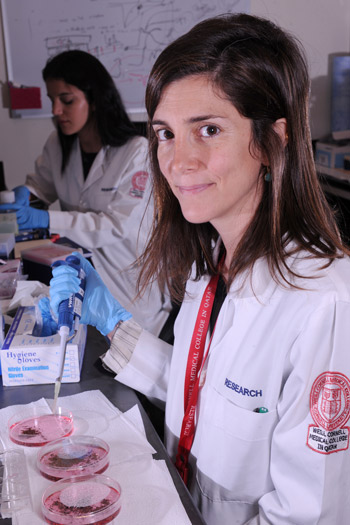Using AI to control energy for indoor agriculture
30 September 2024
Published online 18 July 2018
Scientists identify a protein with an essential role in egg cell maturation.

© Weill Cornell Medicine-Qatar
A team at Weill Cornell Medicine in Qatar aimed to understand the activity of a protein known to be an important player in frog egg cell maturation, membrane progesterone receptor beta (mPRβ). “One of the approaches we decided to use was to identify proteins that interact with and bind to mPRβ,” says Nancy Nader, the study’s lead author.
To do this, they created two different versions of mPRβ by attaching a fluorescent marker at either end. One of the versions remained functional, while the other could no longer play its role in the cell.
By using the two mPRβ versions as bait, the team could identify proteins which interacted with the functional mPRβ but not the defunct form. The most consistent interaction they found was with the very-low-density lipoprotein receptor (VLDLR), a receptor mainly involved in cholesterol uptake and signalling in neurons.
“We were very surprised and initially sceptical when VLDLR was pulled down,” says Nader, since there was no reason to expect VLDLR to be involved in egg cell maturation. To confirm these results, the team knocked down VLDLR in immature frog eggs. This stopped mPRβ from being targeted to its correct location, in the cell membrane, and blocked downstream signalling and egg maturation.
Finally, the researchers used confocal microscopy to follow the position of VLDLR and mPRβ in cells. Without VLDLR, mPRβ doesn’t move from the endoplasmic reticulum to the Golgi bodies, which Nader describes as “crucial for the receptor to become active”.
Without its molecular chaperone, mPRβ fails to reach the correct location in these cells.
Ellis Levin, an endocrinologist at UC Irvine who was not involved in the study, says that the researchers “show that VLDLR chaperones mPRβ to the Golgi, but never address how mPRβ would then traffic to the plasma membrane for signal transduction and biological effects. That would be crucial to complete the story."
The paper also focuses solely on mPRβ – one of five receptors in the mPR family – without addressing the role of others. "Since it's not clear that mPR plays important biological roles in mammals, it's not clear that the role of VLDLR as a chaperone matters," adds Levin.
However, Nader notes that recent studies “are highlighting emerging, potentially important roles for mPRβ in mammals.”
The team is planning further studies to test the connection between VLDLR and mPRβ in other tissues and in mammalian cells, as well as the possibility that VLDLR interacts with the dominant mPR, mPRα. Meanwhile, they are investigating other proteins captured by their mPRβ bait.
doi:10.1038/nmiddleeast.2018.76
Nader, N. et al. The VLDL receptor regulates membrane progesterone receptor trafficking and non-genomic signaling. Journal of Cell Science http://dx.doi.org/10.1242/jcs.212522 (2018).
Stay connected: